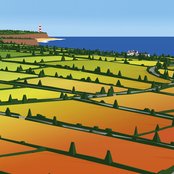Last week, I posted the first part of Andy Dennis’s wonderful exploration of the old roads that formed our area, and received a wonderful response: here, I conclude the piece with some remarkable – and maybe contentious – research.
I am indebted to Andy for such a wonderful piece of research: this compliments the work undertaken by Gerald Reece and I’m sure Kate Cardigan from LichfieldLore will be interested, too.
The high academic standard of this article really cannot be understated.
This sits wonderfully alongside Andy’s other work on the blog on subjects as diverse as local planning matters, more intimate human social history and the precursor physical geography for this post.
I’d like to thank Andy for a remarkable and thorough piece of very professional and engaging research that really adds to the early knowledge on out area, and I’d also like to apologise for sitting on it for so long – it has taken some assembling into a post as all large ones do. My apologies, but as I always say, nothing is wasted.
Old Roads through Brownhills – part 2
Ironstone Road, Blake’s Road and Wolverhampton Lane in the nineteenth century
and earlier.
By
Andrew Dennis
© 2014 All rights reserved

Fig 1. Lines of old road in the Brownhills area in the eighteenth century. Image from Andy Dennis.
Figure 1, above, is an interpretation of available information about some old roads that crossed the Brownhills area before Inclosure and before the reservoir, today’s Chasewater, was constructed. The map is not intended to be at a fixed point in time, but the background is the Ordnance Survey First Edition of 1834, which is the latest mapping available prior to the various Inclosure Acts of the mid-nineteenth century.
Note that Chasewater is larger today and Jeffreys Swag is a more recent addition.
Blake’s Road
In about 1760 a road from Coventry to Stafford passed through the area. It is shown on a manuscript plan (Fig 3, above) running roughly north west from the junction of Watling Street Road and Ironstone Road. Between Coventry Road and Ironstone Road was Hamer’s Field (22a, 2r 12p) and Short Heathy Bank (119a, 3r, 17p). The northern boundary of Short Heathy Bank was Crane Brook. The junction with Watling Street was west of Knaves Castle approximately where Howdles Lane is now.[1]
Gerald Reece (p61) writes:
The Coventry Road ran through Brownhills northward to Stafford. It passed over Aldridge Heath, along Salters Road and crossed the old Chester Turnpike Road at Catshill. From there it continued north to Knaves Castle on the Watling Street. It then proceeded toward Five Ways and Hednesford through the area that is now Chasewater. That section of the road was called Blake’s Road and it formed the ancient boundary between the manors of Norton Canes and Hammerwich.
(Horowitz also suggests the Watling Street to Heath Hayes section ‘was possibly also known as Blakes Road’.[2])
Reece also writes (p91): “An ancient road ran through the middle of this area also, this was the Coventry Road, or locally, Blakes Road. The road had been one of the main arterial routes for centuries but traffic had almost deserted it in favour of town to town travelling.” This was no doubt aided by turnpike roads; the Chester Road was turnpiked in 1759 and Watling Street in 1766.
In 1952 a news article[3] announced that
John Wesley Travelled Along Blake Street.
The author, initials L H and otherwise unidentified, attempted to trace some of the route:
From Huntington Belt to Chad’s Gate the way was fairly easy
…But it seems the route was obliterated by conifer plantations at Pye Green. The remainder of this article appears to have drawn heavily on an earlier article from 1903[4], by F W Hackwood, which adds a little.
Hackwood outlines the route:
…the great highway from Birmingham to Manchester and the north then lay through Perry Barr, by the Horns at Queeslet, over Barr Beacon, through Aldridge over Druid Heath and Walsall Wood, across the Chester Road near Brownhills, by Knaves Castle, through the middle of what is now Norton Pool, a little to the north of Five Ways, through Hednesford, thence by Deakin’s Grave and Huntingdon Belt to Brocton Gate, and so on to Stafford
Hackwood then quotes the Walsall antiquary W H Duignan:
This old way is still very plain over Cannock Chase, and is known (according to locality) as Salter’s Street, Blake Street, the London Road and the Coventry Road. Over the Chase it does not appear ever to have been repaired, and in places, is worn and deep, affording shelter to the few deer still surviving. After the turnpike roads were made between Birmingham and Stafford via Wolverhampton and via Walsall (almost 130 years ago), the old way through Aldridge and Hednesford gradually fell into disuse; but some of the Chester traffic continued to pass through Aldridge until the beginning of the nineteenth century.
I think Duignan was writing in 1884[5], long after the reservoir was built and only referred to the section across Cannock Chase. (I’ve not seen a copy, but 1884 would be consistent with turnpikes being established around 1750-1760.)
Salter’s Street is named. On the line indicated by both Reece and Hackwood, who may both have relied on Duignan, is modern day Salters Road, Walsall Wood, still the main route from Brownhills to Aldridge.
There is no London or Coventry Road on the section between Aldridge and Hednesford, but Stafford Lane and Blake have resonance today.
The 1818 plan names Blake’s Gutter, a watercourse flowing into Fly Bay. In Hednesford is a residential area named Blake, which can be approached via Stafford Lane from the Cross Keys, but do these reflect the old route? The Cross Keys Inn was clearly a staging post on the route between Aldridge and Hednesford as evidenced in John Wesley’s journals. If the true line of Blake’s Road passed Huntington Belt the most logical route from Cross Keys would be Stafford Lane and Belt Road. This seems an indirect route, but it would avoid very steep climbs to the north. Today there is a path or track through Huntington Belt and on through forestry to Broadhurst Green.
From John Wesley’s journals[6], quoted by Hackwood:
February 20. We set out [from Birmingham] as soon as it was light. Before we came to Aldridge Heath, the rain changed to snow, which the northerly winds drove full in our faces and crusted us over from head to foot in less than an hour. We enquired of one who lived close to the moors, which was our best way to Stafford. “Sir”, said he, “’tis a thousand pounds to a penny that you do not come there today. Why ’tis four long miles to the far side of this common and in a clear day I am not sure to go right across it, and now all the roads are covered with snow and it snows that you cannot see before you. However, we went on and did not get ten yards out of the way until we came to Stafford.
It is clear from the extracts of his published journals that Wesley travelled on horseback from Birmingham via Aldridge, Hednesford and Stafford to the north west of England and back several times.
What of the origin of the name Blake? L H says: “the name mostly used in Staffordshire circles in days gone by was Blake Street, which is a Celtic place-name”. I have found no reference to suggest a Celtic origin, but that does not necessarily mean there was none.
Both the Oxford Dictionaries of English Surnames and British Place Names connect Blake and similar with black or dark.
Online there is a one-name study of Blake[7]. Several possible origins are considered, but, given the widespread nature of the name, it seems unlikely to have one lineage and probably refers to persons that were considered dark-skinned. It could also have related to dark or perhaps sinister or foreboding places, such as the open heath as described by the man in Wesley’s journal.
I have found no attribution of the Blake name to a particular person, except that this may be inferred from the use of possessives in Blake’s Road and Blake’s Gutter. There were no Blakes recorded at Hednesford in any of the published England censuses from 1841- 1911. The IGI[8] records many baptisms of Blake in the general area, but only one in Hednesford: Ernest, baptised 10 May 1895, which was too late.
Black? Again, several baptisms in the general area, but none in Hednesford until too recently. Black the colour? The heath would have developed a peaty soil, which would have been black. Maybe coal had something to do with the name.
Hackwood, in an earlier section of the Chronicles of Cannock Chase[9], writes: ‘The name Blake Street is equivalent to ‘Black Street,’ and was so-called because the land on either side was covered in gorse and heath and known as black land or wild land. Black Lees, an old farm three miles south west of Cannock was an old enclosure in the Forest, and thus distinguished from cultivated land.’ Hackwood cites nothing else to support Black.
In the 1861, 1881, 1891 and 1901 censuses the description for the relevant enumeration district says ‘Blakemore’s Gutter’[10]. In the House of Commons the Cannock Chase and Wolverhampton Railway Bill, 1864, referred to Blakemore’s Gutter[11]. In 1905 there was also Blakemore House, Cannock Road, Chasetown, occupied by a grocer and provision dealer named Samuel Jackson Meachem[12]. (The gist was that he had not turned up to bankruptcy court. Just three months earlier he had arrived with family in Montreal, Quebec!)
It is possible that the name of the road and the watercourse are not related or that one succeeded the other. The censuses record several Blakemore families, but none can be readily connected with this location.
Bleak? The road crossed an area of open, blasted heath and would certainly have seemed bleak and remote, especially in mid-Winter!
I suspect the true derivation of the name will never be known for certain.
It is said the road passed Tomkinson’s House. The latest map reference to this is Yates 1798 map, which is supposed to be triangulated, but it is not readily matched to the modern OS grid. My best estimate, using this and the 1760 manuscript plan is that ‘Tomkinson’s’ was somewhere near the western tributary of Crane Brook and near to the old Norton Workhouse (see 1834 OS), which is consistent with a road skirting the low ground of Crane Brook valley between Watling Street and Heath Hayes. This would be on today’s Norton East Road near the junction with School Road. Perhaps Tomkinson’s became the workhouse?
In 1795 land was secured for a reservoir to water the proposed Wyrley and Essington Canal; an area of unenclosed open fields and bog. The ancient Coventry Road ran through this area but was almost deserted in favour of the Chester Road[13]. Presumably, turnpiking of Chester Road and Watling Street, with routes onward to Shrewsbury, Newport and Chester (today’s A41), led to the demise of the old Coventry Road.
Reece says that when the Chester Road was turnpiked in 1759 a toll booth was placed at the junction with the Coventry Road at Old Warren House Farm (later site of the Warreners Arms). The Coventry Road was diverted when the canal was built (1797) (so there would once have been a crossroads with Chester Road) and the toll house moved to Anchor Bridge. The Ogley Hay section of Coventry Road was closed by direction in the Enclosure Act of 1838.[14]
British History Online says:
The road from Aldridge to Hednesford in Cannock via Walsall Wood is mentioned in the early 18th century, passing through the area apparently along the line of the present Northgate, Salter’s Road, Brownhills Road, and Lindon Road to the Chester road at Catshill. [15]
This route would have avoided the long gradient over Shire Oak Hill, which would have been difficult for carts drawn by horses or oxen.
I understand that Northgate was built in the 1950s and 60s as evidenced by OS mapping on BrownhillsBob’s Brownhills Blog: Home on The Grange.[16] It seems more likely that Walsall Wood Road would have been used.
In the Ogley Hay area the 1834 OS map shows a road leaving the Chester Road and winding across the hillside, skirting the highest ground where the parish church stands today, then on to Watling Street west of Knaves Castle, which is where Horowitz says the junction was. This seems the most likely route for Coventry Road at that time.
It would make sense for the Coventry Road to use Watling Street to cross Brownhills Brook and then veer off towards Heath Hayes and Stafford.
The present-day Watling Street, and the road I knew prior to dualling, was clearly raised, perhaps by the Romans, perhaps by the turnpike builders, above the general terrain, which is much lower on the south (common) side and the north side where Knaves Castle Avenue is now at the bottom of a valley. The toll gate, known as Ogley Hay Gate, stood where the ground becomes level with the road on the west side of the valley. It seems unlikely that the toll gate would have been built on the line of Coventry Road, over which rights of way would have existed, so that road probably turned off Watling Street a little further west. If the toll gate was positioned deliberately so that all traffic had to pay toll it may have directly caused the demise of Coventry Road from 1789. Naturally, this would have been in the interests of the toll collector. Perhaps what is now Chapel Street, or ‘the back lane’ as it was known, is an echo of the old Coventry Road?
Looking east. Howdles Lane is just beyond the green lights. The turnpike stood where the speed camera is, with a turnpike house opposite, under the westbound (right hand) carriageway, before the bus stop. There is no significant dip.
Looking north from the Black Path. The traffic signals are the same as those in the top image. Brownhills Brook now flows through a pipe under the right hand side of the path about a metre below surface. The rooftops to left of the traffic signals are on two storey houses on Knaves Castle Avenue.
Welsh Harp
At the junction of Watling Street and Coventry Road was the Welsh Harp. It is said that the Old Irish Harp at Little Aston was previously the Welsh Harp in recognition of Welsh traffic, so this hostelry might have been named for the same reason.
It has been suggested that the name Watling is derived from an old version of Welsh, but the Encyclopaedia Britannica says:
Watling Street, Roman road in England that ran from Dover west-northwest to London and thence northwest via St. Albans (Verulamium) to Wroxeter (Ouirokónion, or Viroconium). It was one of Britain’s greatest arterial roads of the Roman and post-Roman periods. The name came from a group of Anglo-Saxon settlers who called Verulamium by the name of Wætlingaceaster. This local name passed to the whole of the Roman road (Wæclinga stræt) by the 9th century. The tendency t0 give the name to other main roads is postmedieval and is often mere antiquarianism. [17]
In the 18th century the Chester Road was known as the Welsh Road to reflect its use by Welsh drovers taking cattle to London, but it is clear that drovers also used Watling Street via Atherstone and Northampton[18]. Droving seems to have been going on in the 8th century and there are records of cattle brought from Anglesey in the 15th century. On Yates 1775 and Cary’s 1806 maps Coventry Road is shown north west from Tomkinson. Neither Coventry Road nor the Welsh Harp is shown on Yates 1798 or later maps.
Behind the Welsh Harp (1760) and named (1818)[19] was Homar’s Field. This may have been the land west of the Brownhills Brook and east of what is now Whitehorse Road. It was a little more than 23 acres. The obvious reason for a field being there is to accommodate cattle while drovers stayed overnight; this would have been roughly a day’s drive from Stafford.
Wolverhampton Lane
Film supplied by Andy Dennis
I have long thought that Brownhills Road, branching south west from Watling Street through Ogley Hay was very old. It is not visible now in consequence of the motorway, but it left Watling Street just west of the Crane Brook crossing[20], though the 1834 map shows the junction east of the crossing. It is worth bearing in mind that Crane Brook would have been a more substantial stream before most of it was diverted into canals; some indication is given by the Chasewater overflow after prolonged rain. The valley floor is largely hidden by modern roads and other development, but is quite wide north of Watling Street, before entering a small gorge, and may have been a substantial obstacle. The Roman road appears to have been on an embankment or causeway.
Further indication of the true location of the junction with Watling Street is the location of routes from Hammerwich to the same point. Before the motorway there was a public footpath continuing south from Church Lane, Hammerwich, across fields to a point immediately opposite (then) Brownhills Road. The 1834 mapping shows a different, more westerly, route.
It appears that a route existed between Lichfield and Wolverhampton in the twelfth century. This followed what is now the A461 from Lichfield via Pipe Hill to Muckley Corner. It continued along Watling Street to Crane Brook and then via Ogley Hay, Pelsall and Wednesfield to Wolverhampton.[21] In the early, and mid-nineteenth century what is now Pelsall Road, was Wolverhampton Lane[22].
However, most pilgrims would have travelled on foot or horseback, and some folk used pack animals. Passing through Hammerwich would not seem an illogical continuation. It seems reasonable to suppose that there would have been regular traffic between Ogley Hay and Hammerwich and these paths could have been used for that. Perhaps some travelled onwards to Farewell and Stonywell? At Farewell was religious house in the twelfth century and later a Benedictine priory.
Lichfield as an ecclesiastical centre goes back to at least 669 and maybe to 300 AD.[23] Wolverhampton’s minster church was founded in 994. This is the earliest reference I can find to Wolverhampton.
Presumably, it would not have taken long for people, such as pilgrims, and goods to move between the two, so on that basis alone the Wolverhampton to Lichfield route is likely to be over 1,000 years old. Hooke’s map suggests the road was used at the time of the Staffordshire Hoard burial.

Fig 8. OS Pathfinder Sheet SK 00/10. Junction of Watling Street, Brownhills Road and footpath from Hammerwich. Image from Andy Dennis
- Reece, p87.
- Horowitz, p39.
- Lichfield Mercury Friday 11 January 1952, p8, col4.
- Lichfield Mercury 12 June 1903, p3, col 4, The Chronicles of Cannock Chase, XLII Communications with Cannock.
- Duignan W F, 1884, On Some Midland Etymologies, IN The Midland Antiquary, Horowitz, p67.
- Parker, Percy Livingston (Ed.), 1951, The Journal of John Wesley, Chicago, Moody Press, as published online by the Christian Classics Ethereal Library.
- Guild of One-Name Studies – http://www.one-name.org/profiles/blake.html
- International Genealogical Index, online, operated by FamilySearch.org.
- Hackwood, FW, 1902, The Chronicles of Cannock Chase, III – The supposed abode of the Arch- Druid, IN Lichfield Mercury 26 September, p3 col4.
- 1861, Staffordshire, Hammerwich, dist 13, p1; 1881 Burntwood Edial and Woodhouses, dist 13, Description of Enumeration District, col2, 1891, Burntwood, dist 13, p1; 1901, Burntwood, dist 12
- Birmingham Dailly Post 21 Jun 1864.
- Lichfield Mercury 1 Sep 1905.
- http://www.chasewater.org.uk/history.htm
- Reece, p61.
- http://www.british-history.ac.uk/report.aspx?compid=36204&strquery=hednesford#n45 re S.R.O., Q/SO 11, T. 1708; Yates, Map of Staffs.(1775); Willmore, Walsall, 375
- http://brownhillsbob.com/2012/11/10/home-on-the-grange/
- http://www.britannica.com/EBchecked/topic/637595/Watling-Street
- Welsh Cattle Drovers in the Nineteenth Century Richard Colyer National Library of Wales journal. 1974, Summer. Volume XVIII/3
- Reece pp 87 and 93.
- Ordnance Survey Pathfinder Series 1:25,000, 1976, compiled from 1:10,560 or 1:10,000 made from surveys 1956-1974. Confirmed by aerial photography from 1971.
- Hooke, Fig 6.
- England censuses and Ordnance Survey mapping 1884.
- http://lichfield-cathedral.org/History/the-saxon-church-a-name-and-a-legend.html




 RSS - Posts
RSS - Posts








Watling Street the Milky Way…
http://www.indigogroup.co.uk/edge/Royalrds.htm
Interesting!
So I travelled the Milky Way to and from school, munching a Mars Milky Way as I returned …
Absolutely fascinating, thank you for this. Living in Pye Green now I would be interested on more information on the Blake route from the Belt road region on towards Stafford, would it have followed the route of Lime pit lane now or cut more across the Chase?
Hello Stuart.
The route indicated by Hackwood suggests that continuing from today’s Belt Road along Limepit Lane to Huntingdon Belt then on to Deakin’s Grave and Brocton Gate.
On the A-Z is Limepit Gate from where a track goes north through Huntingdon Belt crossing the track going west from Pye Green, before going off the map.
The OS 1:25,000 map shows this route continuing to Broadhurst Green, from where you can join the line of Camp Road past Springslade Lodge to the A34 near Brocton. Note there is a Brocton Gate Farm on Camp Road just short of the junction.
The OS 1st Edition (1834) shows what is now Stafford Lane and Belt Road, then a road on the east side of Huntingdon Belt and the east side of Bednall Hill Wood (today’s Bednall Belt Plantation?), but no link between Broadhurst Green and Springslade Lodge. It also shows Brocton Gate clearly on the line of Camp Road where Brocton Gate Farm is and not on the line of the A34 Cannock Road. Deakin’s Grave is also shown on the Camp Road line.
Hypothesis: The old road from Cannock also followed this Camp Road line, but a new or upgraded road was constructed prior to the 1834 mapping (surveyed about 12 years earlier) and replaced the old road across Cannock Chase (as we know it today).
How to test it? There was a turnpike at “Cannock Road, Acton” – see http://www.turnpikes.org.uk/Tollhouses%20of%20Staffordshire.htm – which may have stood near to Aston Hill (where the A34 enters the Stafford built up area today). On the OS 1st Ed “T.G.” is shown a short distance SE of that junction, possibly where the road turns off to Walton on the Hill (see http://www.visionofbritain.org.uk/maps/results.jsp?xCenter=3162500&yCenter=3175000&scale=63360&mapLayer=nineteenth&subLayer=first_edition&title=Ordnance).
This is a bit off our patch, so it maybe that Stafford or Brocton folk can offer more.
Anyway, hope this helps.
Cheers Andy, need to get my walking shoes on, I’m not over familiar with this area being Chasetown born and bred, I’m still more of a Chasewater person.
Notes on Place names in Staffs by WH Duignan 1902
Blake Street, the name of an ancient road forming a portion of the boundary between the parishes of Shenstone and Sutton Coldfield, and the counties of Stafford and Warwick. 13 c. Blakestret; and the locality Blakele, Blakeleye. It is often supposed that ‘street’ indicates a Roman road, but it is only evidence of antiquity. In A S charters, which have no pretension to Roman origin are frequently termed ‘straet’ (street). The country around Blake Street was heath ground until the middle of the last
century. Blake = black, and the meaning is ‘ Black Street’ (v. Black Lees). An ancient road called Blake Street, once a portion of the great London and Chester road, now diverted, formerly extended over Cannock Chase, between Brownhills and Hednesford, and formed (its line still forms) a manorial boundary. In the year 1300 it is written Blake streete; in 1595 ‘Black street’. It was all wild land.
Interesting! I wonder what were his sources in 1300 and 1595. Might need help from Prof. Michael Wood …
Notes on a Place names in Staffs by WH Duignan 1902
This can be accessed online, albeit with some pages missing if you are not registered. Watling Street’s description has one missing!
http://www.forgottenbooks.com/download_pdf/Notes_on_Staffordshire_1000895698.pdf
Pingback: Howdles Lane and The Marquis – Andrew's Kindred